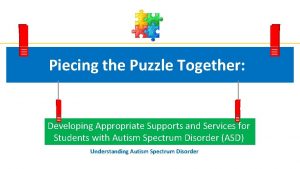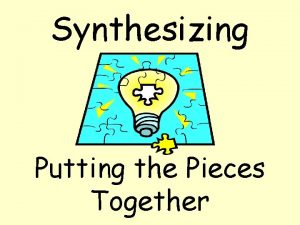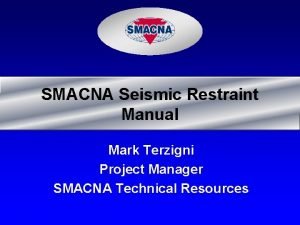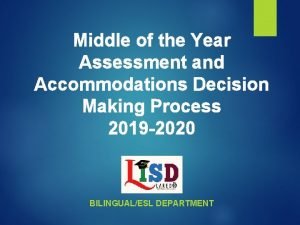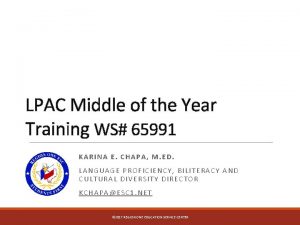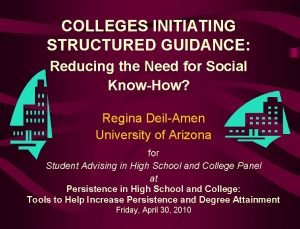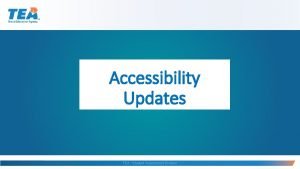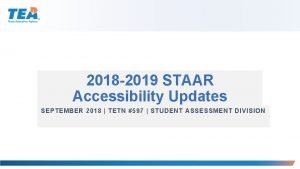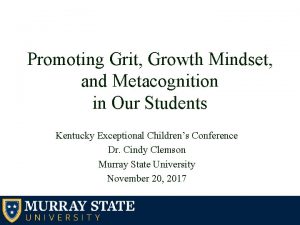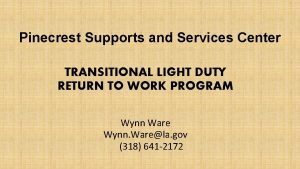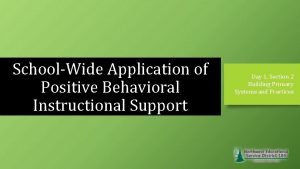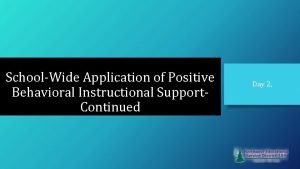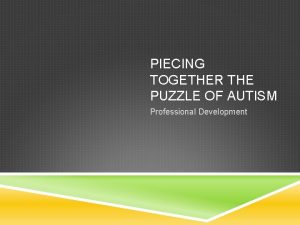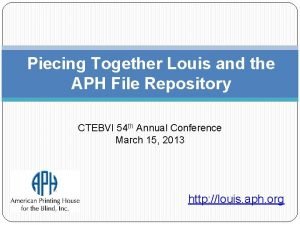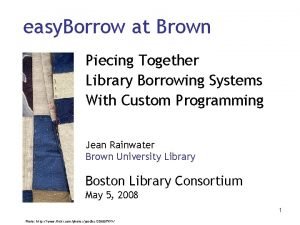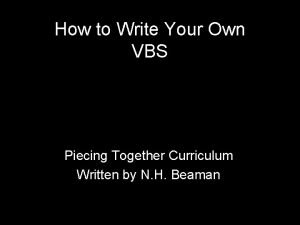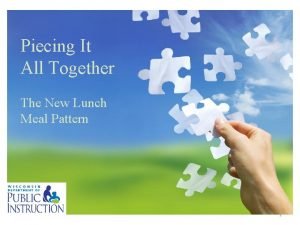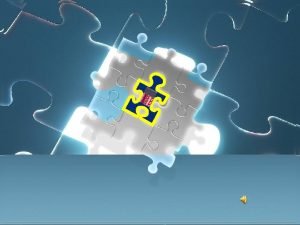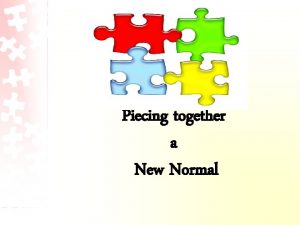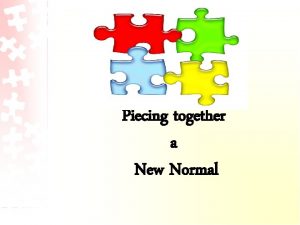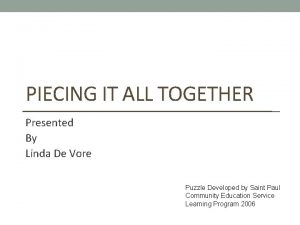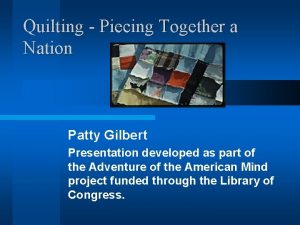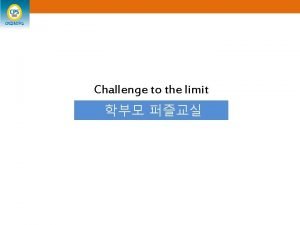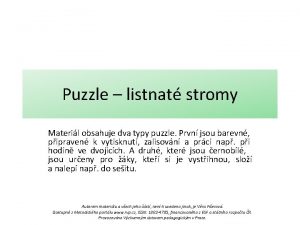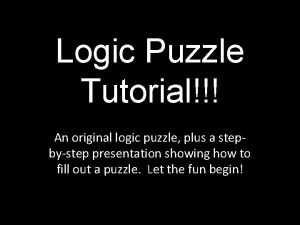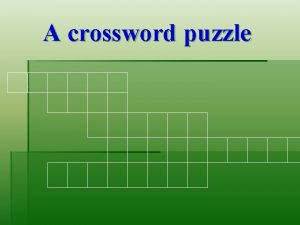Piecing the Puzzle Together Developing Appropriate Supports and
















![What limitations is the [student] experiencing? What accommodations are available to reduce or eliminate What limitations is the [student] experiencing? What accommodations are available to reduce or eliminate](https://slidetodoc.com/presentation_image/2116fbfd49666e7e6ba86abe7f818b7c/image-17.jpg)






















- Slides: 39

Piecing the Puzzle Together: Developing Appropriate Supports and Services for Students with Autism Spectrum Disorder (ASD) Understanding Autism Spectrum Disorder

Objective #1 Objective #2 Objective #3 Objective #4 List 2 -3 of the common characteristics (e. g. , functional limitations) of someone on the autism spectrum. Identify 1 -2 accommodations to support each functional limitation identified. Articulate how accommodations on a student’s center accommodation plan may be applied via distance learning. Determine if the accommodations are effectively supporting the identified functional limitation by reviewing participation and performance outcomes. 2

Professor Andrew Whitehouse, Lead of Autism Research Team, Telethon Kids Institute 3

ASD Defined 4 4

Review of General Functional Limitations § Social Communication § Restrictive/Repetitive Behaviors § Sensory-related Responses § Anxiety § Learning-related (varies greatly dependent upon where the person is on the spectrum, presence of co-morbid disorders, etc. ) The Center on Secondary Education for Students with Autism Spectrum Disorders (CSESA) 5

Potential Functional Limitations uch as s s e is o n d u o L ells class change b t Multiple concurren noises, people talking, lights buzzing, pencils writing Sudden changes in routines Fluorescent Lighting Touch Crowded spaces; Unexpected touch Meals Food textures; Change in menus 6

Anxiety and Autism 7

Dr. Temple Grandin, Ph. D. Food for Thought… § Students on the autism spectrum often have spent SO much time dealing with their environments and sensory overload, that they missed and continue to miss opportunities to observe, absorb, and emulate appropriate social skills. § These and other skills often must be explicitly taught. § We can modify environmental triggers and accommodate sensory functional limitations to mitigate impact. 8

9

SUPERPowers – Strengths! 10

Communication 11 11

Communication – Generally § Your obligation to communicate effectively with people with disabilities – whether those people are students, staff, applicants for admission or employment, parents, guardians, or members of the public – is separate from your obligation to provide reasonable accommodations for qualified people with disabilities. 12

Legal Obligations § The Workforce Innovation and Opportunity Act (WIOA) nondiscrimination regulations, distinguish between these two obligations, for a very simple reason: § Without clear, accurate, effective communication, any encounter between a person with a disability and a program from which he or she is seeking services, such as Job Corps, will be literally meaningless. 13

Communication – Applicant File Review The applicant File Review Team (FRT) and the Reasonable Accommodation Committee (RAC): § MUST provide communication-related accommodations during the clinical and or interactive reasonable accommodation process interviews for a person with ASD 14

What IS a Communication-related Accommodation? Top 5 Tips for Communicating with an Individual with ASD § Any adjustment or modification, support, and so forth that enables the individual to be able to both receive and express information in a way that is meaningful to them. 1. Write it down. Even if I can’t read, it will make your words “permanent. ” If it’s important, write it down. 2. Keep it simple. I get easily overwhelmed with too much talking. 3. Give me time. It may take me several seconds to respond to your question. 4. Slow down. Allow one piece of information to be processed at a time. 5. One person at a time. I can’t process multiple speakers simultaneously. 15

Distance Learning 16 16
![What limitations is the student experiencing What accommodations are available to reduce or eliminate What limitations is the [student] experiencing? What accommodations are available to reduce or eliminate](https://slidetodoc.com/presentation_image/2116fbfd49666e7e6ba86abe7f818b7c/image-17.jpg)
What limitations is the [student] experiencing? What accommodations are available to reduce or eliminate these problems? Are all possible resources being used to determine possible accommodations? Determining Accommodation Needs (askjan. org) How do these limitations affect the [student] and the [student’s] performance in academics and career technical training activities? What specific tasks are problematic as a result of the limitations? 24

Once accommodations are in place, have you “met” with the student to evaluate the effectiveness of the accommodations and to determine whether additional accommodations are needed? Do staff and other students need training? What specific tasks are problematic as a result of the limitations? Determining Accommodation Needs (cont. ) 25

A Tip for Your Consideration! § When working with students who have ASD, it is often important that staff approach various tasks the same way. For example, if a math teacher teaches a math concept one way and the career technical instructor teaches it a different way, it may be confusing for the student who has ASD. § This is a situation in which the use of applied academics, co-teaching, or collaboration between those two instructional staff is strongly encouraged! Task Analysis e task? h t is t a h W 1. teps in s e h t y if t n e 2. Id list the task and r. them in orde e task h t e r a h S. 3 h other it w e c n e u q e s staff! 19

Video Modeling Point-of-view video modeling Basic video modeling § In Point-of-view video § Video modeling consists of modeling, the videotape is recording another individual created to show the (e. g. , adult, peer, sibling) behavior would look from the performing the desired or learner's point of view. targeted behavior. Video self-modeling Video Prompting § In video self-modeling, the § Finally, video prompting is the learner is recorded performing process of showing sequences of the target behavior while any behavior in different clips. The inappropriate or other video is stopped after each behaviors are edited out of segment for the student to the final video. practice the modeled behavior. Draws on strong visual skills Can be used repetitively Can include positive reinforcement 20

Autism Internet Modules autisminternetmodules. org 21

ASD in the Workplace 22 22

How Can You Improve Employment Outcomes § Work on interview skills § Identify companies with neurodiversity and autism hiring programs § With the student’s permission, collaborate with other supporting agencies such as Division of Vocational Rehabilitation § Secure a Job Coach § Use video modeling!! 23

Accommodations in the Workplace! 24

Case Study 25 25

Rebecca 26

Let’s learn about Rebecca… § Rebecca is 16 years old and is interested in carpentry. § She has a diagnosis of ASD, Depression, Generalized Anxiety Disorder and a Learning Disability, specifically Dysgraphia (along with other written expression challenges). § She struggles with hand-to-eye coordination. § She is averse to certain food textures. § She has excellent recall for facts when presented with information orally. 27

Functional Limitations § What limitations is Rebecca experiencing? § Anxiety (when? ) § Anxious about completing tasks that are difficult for her § Results in attention, memory, and organizational challenges § Takes longer to complete tasks § Feels overwhelmed at times § Hand fatigues with handwriting and generally is illegible; Struggles to initiate tasks when writing on paper § Cannot replicate shapes or attend well to information on white backgrounds § Becomes nauseous and/or gags when attempting to eat certain food textures 28

Accommodating Specific Functional Limitations § Is Rebecca entitled to testing accommodations (i. e. , TABE)? § What are some accommodations you can provide related to her visual -spatial/figure-ground challenges? § Templates § Rulers § Manipulatives § Computer, tablet, or phone apps § Color-coding § What do you do about the food aversion functional limitation? 29

Considering Applicant/ Student Strengths § How can we use her strengths to support the development of a strong Accommodation Plan (AP)? Remember, she has excellent recall for facts/details when given information orally? 30

Effectiveness of Accommodations § Once accommodations are in place (within 60 days and every 60 days thereafter), has the ESP met with Rebecca to evaluate the effectiveness of the accommodations and to determine whether additional accommodations are needed? § Use required Disability Program effectiveness reviews (via ESPs) to monitor for accommodation implementation and effectiveness. 31

Implementation/Management of Accommodations § Do staff and other students need training? § Do staff need information and practice on using various apps or accommodations? 32

Remember! § A person with Autism Spectrum Disorder (ASD) is a unique individual. “Communicating” with them, learning about their specific functional limitations, and then developing accommodations that fit their specific needs is essential. § However, developing an accommodation plan in CIS is not enough – the center must go the next step and ensure that the accommodations are implemented center-wide, and that staff understand the importance of these accommodations to the individual’s ability to access and participate in the Job Corps program. 33

Difficulty managing loud noises Headsets Dorm Room Selection Schedule adjustments OTHER types of accommodations for students with ASD Struggles with motor coordination Difficulty with reciprocal conversation Schedule adjustments Picture supports Voice dictation software Peer Buddy/Mentor Alternate uniforms/fasteners Breaks/Passes Lower bunk Fidget items Harness on scaffolding Social Stories Role Playing Videotaping 34

Resources 35

Virginia Commonwealth University Research and Rehabilitation Research and Training Center https: //vcurrtc. org/ 36

Autism Speaks https: //www. autismspeaks. org/our-work 37

Job Corps Disability Website https: //supportservices. jobcorps. gov/disability/Pages/default. aspx 38

Job Corps Disability Website https: //supportservices. jobcorps. gov/disability/Pages/Common-Disabilities-Spectrum-Disorders. aspx 39
 Examples of functional limitations
Examples of functional limitations After putting the pieces together, what do they look like?
After putting the pieces together, what do they look like? Opvoedbelasting
Opvoedbelasting Smacna hangers and supports
Smacna hangers and supports Staar alt 2 justification examples
Staar alt 2 justification examples Staar content and language supports
Staar content and language supports Structured guidance and supports
Structured guidance and supports Manipulating test materials staar
Manipulating test materials staar Staar content and language supports
Staar content and language supports Metacognition and growth mindset supports grit.
Metacognition and growth mindset supports grit. Pinecrest supports and services center
Pinecrest supports and services center Positive behavioral interventions and supports
Positive behavioral interventions and supports Positive behavioral interventions and supports
Positive behavioral interventions and supports Hát kết hợp bộ gõ cơ thể
Hát kết hợp bộ gõ cơ thể Lp html
Lp html Bổ thể
Bổ thể Tỉ lệ cơ thể trẻ em
Tỉ lệ cơ thể trẻ em Chó sói
Chó sói Tư thế worms-breton
Tư thế worms-breton Chúa yêu trần thế
Chúa yêu trần thế Môn thể thao bắt đầu bằng chữ f
Môn thể thao bắt đầu bằng chữ f Thế nào là hệ số cao nhất
Thế nào là hệ số cao nhất Các châu lục và đại dương trên thế giới
Các châu lục và đại dương trên thế giới Công của trọng lực
Công của trọng lực Trời xanh đây là của chúng ta thể thơ
Trời xanh đây là của chúng ta thể thơ Mật thư anh em như thể tay chân
Mật thư anh em như thể tay chân Làm thế nào để 102-1=99
Làm thế nào để 102-1=99 Phản ứng thế ankan
Phản ứng thế ankan Các châu lục và đại dương trên thế giới
Các châu lục và đại dương trên thế giới Thể thơ truyền thống
Thể thơ truyền thống Quá trình desamine hóa có thể tạo ra
Quá trình desamine hóa có thể tạo ra Một số thể thơ truyền thống
Một số thể thơ truyền thống Cái miệng bé xinh thế chỉ nói điều hay thôi
Cái miệng bé xinh thế chỉ nói điều hay thôi Vẽ hình chiếu vuông góc của vật thể sau
Vẽ hình chiếu vuông góc của vật thể sau Nguyên nhân của sự mỏi cơ sinh 8
Nguyên nhân của sự mỏi cơ sinh 8 đặc điểm cơ thể của người tối cổ
đặc điểm cơ thể của người tối cổ Thế nào là giọng cùng tên?
Thế nào là giọng cùng tên? Vẽ hình chiếu đứng bằng cạnh của vật thể
Vẽ hình chiếu đứng bằng cạnh của vật thể Phối cảnh
Phối cảnh Thẻ vin
Thẻ vin
